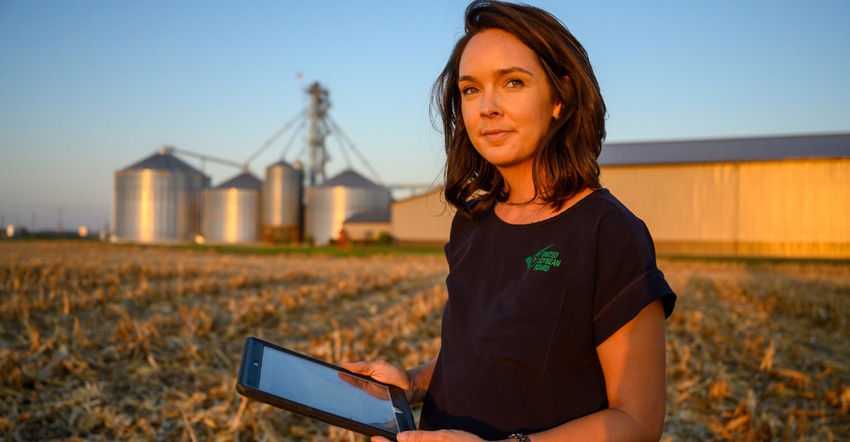
When Meagan Kaiser looks across her soybean fields in Missouri, she sees a land of opportunity for 2022.
“I think the oil aspect of soybeans is going to boom for us in the next two years,” she says. Kaiser was recently elected to serve as vice chair of the United Soybean Board, which oversees checkoff dollars from soybean producers across the nation. And the board has a strategic plan to put soy in every life, every day.
Soy out front
For a long time, Kaiser notes, that aspect of placing soy in front of consumers every day meant mainly as a protein in animal feed or consumer diets. However, consumer buying perspectives shifted over the years to focus on how items are produced. Many are looking at “green” products.
Now putting soy in everyday consumer lifestyles takes the shape of renewable alternatives displacing petroleum, such as oil in asphalt, engine oil or even in tires, she says. Currently, soybeans are used as an ingredient in 1,000 different products, and the United Soybean Board is researching more possibilities such as bale films and plastics. Still, Kaiser contends soybeans have always been a part of green innovation for more than 90 years.
Henry Ford found many uses for soybeans. In the 1930s, Ford sought out ways to bring farming and industry together with soybeans. He built a soybean laboratory in Greenfield Village in Dearborn, Mich., that led to the use of some soy-based oils and plastics in Ford Motor Co. vehicles.
While some of today’s soy innovations are not necessarily new, Kaiser notes, today the oil aligns more closely with an emphasis on sustainability seen in the marketplace.
“Not only are we able to do it in a very efficient and environmentally friendly way to produce the bean, but then it alleviates our dependence on fossil fuels and other nonrenewable resources,” she says. “It's kind of a special moment for the soy industry as the green alternative. And I think that we share that value, and it’s exciting that we get to be a big part of the solution for a lot of the world’s problems.”
Realizing soy value
Kaiser says soy oil advancements come through investment by farmers through the checkoff. And so far, it is producing a good return on investment for soybean growers, according to a recent study.
The latest mandatory five-year independent economic evaluation, conducted in 2019, found that U.S. soybean farmers received an estimated $12.34 in added value for every dollar they invested in the checkoff. “That is a huge return on investment,” she says. “I think it’s amazing how much we’re doing and how quickly we are doing it, and the amount of discovery there is.”
Serving farmers for the future
This is Kaiser’s sixth year on United Soybean Board. “What’s so special about the checkoff is that it’s farmer driven,” she says. “It is great that I get to represent Missouri. It’s also a little bit humbling when you think about how different our production practices are here compared to in North Dakota or in Mississippi.”
She stresses the importance of a diverse board from across the U.S. that brings in all perspectives of the industry.
“There are 78 farmer-leaders that take a lot of time to dig into these projects and bring the perspective of their home farm and their home state, which is really meaningful,” Kaiser says, adding that the board spans many generations. “I have small children, and there are those with grandchildren. We’re raising a generation behind us, and we’re working with a generation ahead of us. It really hits home how important the checkoff is to make sure that it is a viable industry for the future.”
About the Author(s)
You May Also Like






